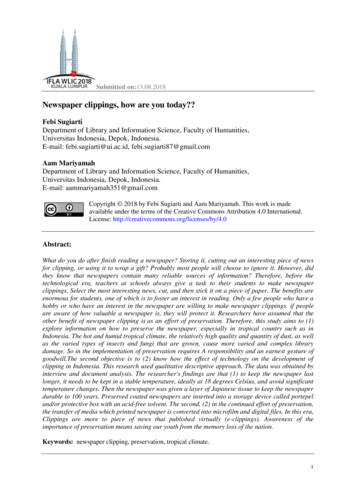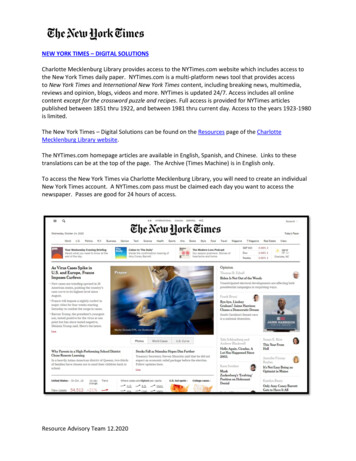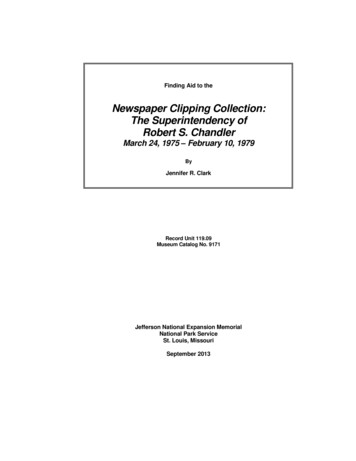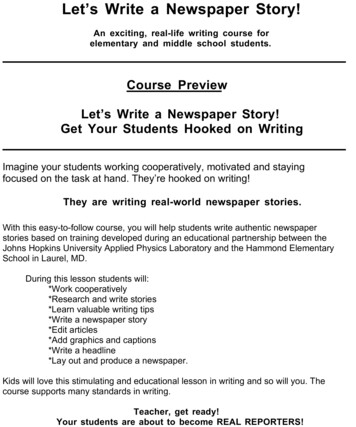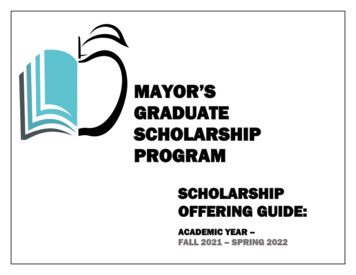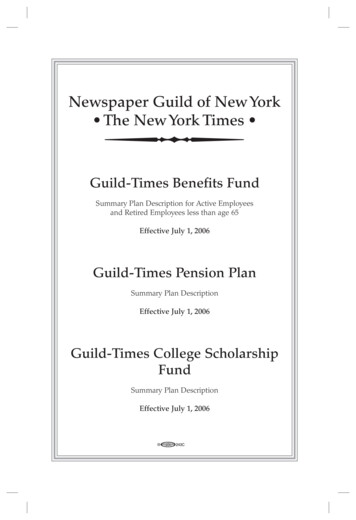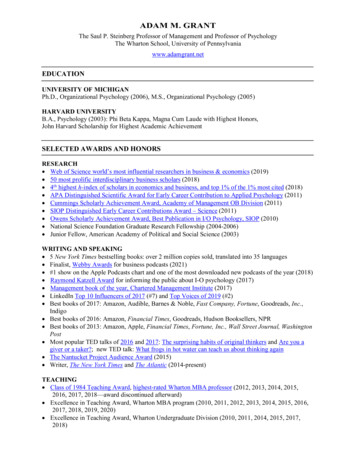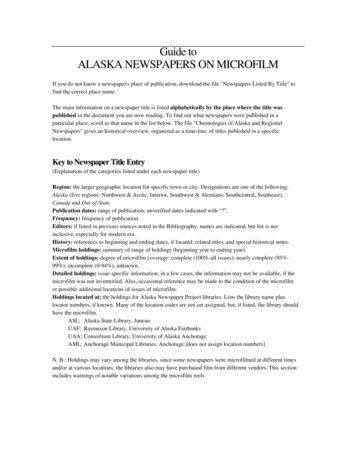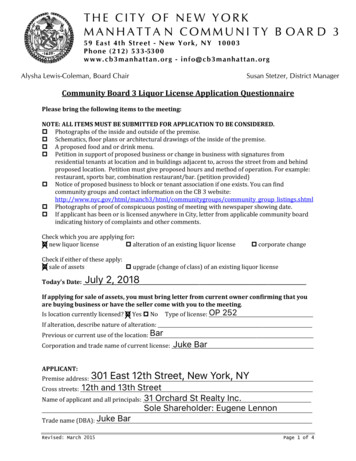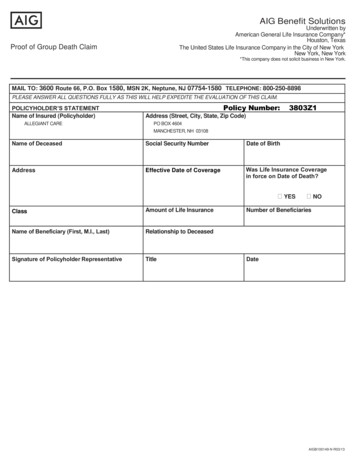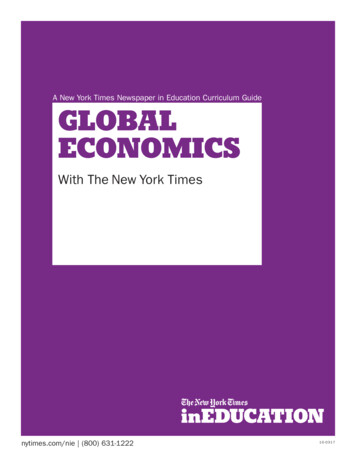
Transcription
A New York Times Newspaper in Education Curriculum GuideGLOBALECONOMICSWith The New York Timesnytimes.com/nie (800) 631-122210-0317
TABLE OF CONTENTSTEACHING GLOBAL ECONOMICS WITH THE NEW YORK TIMESINTRODUCTION . . . . . . . . . . . . . . . . . . . . . . . . . . . . . . . . . . . . . . . . . . . . . . . . . . . . . . . . .2Using The New York Times as a Teaching Strategy . . . . . . . . . . . . . . . . . . . . . . . . . . . . . . . . . . . . . . . .2Rationale . . . . . . . . . . . . . . . . . . . . . . . . . . . . . . . . . . . . . . . . . . . . . . . . . . . . . . . . . . .2Structure of the Lessons . . . . . . . . . . . . . . . . . . . . . . . . . . . . . . . . . . . . . . . . . . . . . . .2Time Frame . . . . . . . . . . . . . . . . . . . . . . . . . . . . . . . . . . . . . . . . . . . . . . . . . . . . . . . . .3The New York Times Learning Network (learning.blogs.nytimes.com) . . . . . . . . . . . .3Globalization: An Introduction by Dr. Peter F. Bell . . . . . . . . . . . . . . . . . . . . . . . . . . . . . . . . . . .3Globalization: The Problems . . . . . . . . . . . . . . . . . . . . . . . . . . . . . . . . . . . . . . . . . . . .3Globalism: A Brief History . . . . . . . . . . . . . . . . . . . . . . . . . . . . . . . . . . . . . . . . . . . . .4Goals of the Lessons . . . . . . . . . . . . . . . . . . . . . . . . . . . . . . . . . . . . . . . . . . . . . . . . . .5Standard Materials Needed for Each Class . . . . . . . . . . . . . . . . . . . . . . . . . . . . . . . . .5LESSONSLesson 1Lesson 2Lesson 3Lesson 4Lesson 5Lesson 6Lesson 7Lesson 8Lesson 9Lesson 10Lesson 11Lesson 12Lesson 13Lesson 14Identifying Global Issues: The New York Times Clippings Project . . . . . . . . . . . . . . .6The Global Economy and the Global Village . . . . . . . . . . . . . . . . . . . . . . . . . . . . . . .9Measuring the Costs and Benefits of Trade . . . . . . . . . . . . . . . . . . . . . . . . . . . . . . . .12What Do We Mean by Development? . . . . . . . . . . . . . . . . . . . . . . . . . . . . . . . . . . .15Human Development and Gender Development . . . . . . . . . . . . . . . . . . . . . . . . . . .17How to Improve Development . . . . . . . . . . . . . . . . . . . . . . . . . . . . . . . . . . . . . . . . .20Understanding Development in Specific Countries . . . . . . . . . . . . . . . . . . . . . . . . . .22What Determines Economic Growth? . . . . . . . . . . . . . . . . . . . . . . . . . . . . . . . . . . . .27Free Trade and Development: The Impact of Nafta . . . . . . . . . . . . . . . . . . . . . . . . .29Understanding Major Institutions of Globalization:the World Bank, I.M.F. and W.T.O. . . . . . . . . . . . . . . . . . . . . . . . . . . . . . . . . . . . . .31Rich and Poor Countries: Can Foreign Aid and Foreign Investment Help? . . . . . . .32The Impact of Globalization on Culture . . . . . . . . . . . . . . . . . . . . . . . . . . . . . . . . . .34Globalization and “Sweatshops” . . . . . . . . . . . . . . . . . . . . . . . . . . . . . . . . . . . . . . . .36Globalization: What Are the Alternatives? . . . . . . . . . . . . . . . . . . . . . . . . . . . . . . . . .39APPENDIXCorrelation to the Standards of the National Council on Economic Education . . . . . . . . . . . . . . .41Archive of Related New York Times Articles . . . . . . . . . . . . . . . . . . . . . . . . . . . . . . . . . . . . . . . . .42Written by Dr. Peter Bell, Executive Director, New York State Council on Economic Education; Associate Professor ofEconomics, State University of New York at Purchase. Contributing Writer, Ellen S. Doukoullos. This educator’s guidewas developed by The New York Times Newspaper in Education program. It did not involve the reporting or editing staffof The New York Times. 2010 The New York Times nytimes.com/nie (800) 631-1222 1
Global Economics With The New York TimesINTRODUCTIONUSING THE NEW YORK TIMESAS A TEACHING STRATEGYA Message from the Newspaper in Education Program The daily Business section provides still more coverage ofinternational economic issues as well as useful tables andanalytical charts. The daily Sports section reports news of international andRATIONALECapturing student interest in global issues is a challenge formany teachers of global economics. The troubles of distantnations and their peoples long seemed irrelevant to manyAmerican students who are surrounded by a wealth ofresources and unlimited opportunities.Using The New York Times as a teaching strategy willbring the world to your students in an easy-to-use format.You and your students will find the entire New York Timesnewspaper is rich with global content. Times reporters live and work in every hemisphere of theworld, bringing a first-hand knowledge of the impact ofmany factors like war and social change on the economichealth of large and small nations. Their reports appear on thefront page of The Times as well as on the International pagesin section A. The World Briefing and News Summary, alsoin section A, provide a quick summary of news from all partsof the globe. The “Journal” feature appears most days of the week, withevents and datelines from a different part of the world. Thesehuman interest stories often reveal the stunning impact ofeconomic disruption and decay on families. Analysis pieces that frequently accompany news reportsprobe behind the raw facts and provoke thinking about thebig issues. These pieces are models for writing and instruction in critical thinking. The Editorial and Op-Ed (opposite the Editorial page) andletters pages frequently discuss global economic issues. Thesepages are models and prompts for essay-writing. Ads throughout The New York Times display goods from allaround the globe. The Times is a global marketplace for thesegoods. Students can see the impact of economic decisions made faraway on the pages of the newspaper they hold in their hands.national sports events and athletes, including analysis of thebusiness of sports. Wednesday’s Times reports on foods and beverages – oftenfrom around the globe — and the industries associatedwith them. The Science Times section, published on Tuesday, includesreports of the economics of health care around the globe. The Arts section reports daily on issues such as globalentertainment and the publishing industry. Articles aboutthe economic impact of copyright conflicts, for example,may appear in this section as well as in the main news andbusiness sections. Labor issues, restructuring of companies and emergingprofessions are part of many reports throughout The NewYork Times.The New York Times becomes your “living textbook.” Weencourage you and your students to read, analyze, clip andre-read salient items from its pages each day.STRUCTURE OF THE LESSONSThe Objectives for each lesson are designed as an assessmentof learning. Students will demonstrate their understanding ofthe concepts taught by creating a measurable product — suchas an essay in the style of the Op-Ed page or news analysisin The New York Times, a chart or role-playing labor issues.The Newspaper Activity takes students into today's NewYork Times to demonstrate that the complex economic issuesare a continuing story happening right now. Using thecurrent day’s issue will engage your students in theimmediacy of global economics.Some lessons include Times articles from the archivesto be used as models for direct teaching of analysis andcritical thinking skills. After students read them, they shouldturn to today’s Times and apply the skills to current reportsof global economic activity. nytimes.com/nie (800) 631-1222 2
Global Economics With The New York TimesINTRODUCTIONCooperative/collaborative learning activities are specifiedwhen a concept needs to be analyzed from differentapproaches. The small groups should be composed of threeor four students.Extension/homework activities provide research opportunities for advanced classes, writing assignments and opportunitiesfor problem-solving.Web sites provide up-to-date tables of data from manysources such as the United Nations and World Bank. Thesereferences are included for both teacher and students.TIME FRAMEEach lesson plan focuses on a specific global economicsconcept. The lessons build on each other toward anunderstanding of the global economy.Build the lessons into your teaching schedule. Use theactivities in class and as homework. We recommend dailyreading of The New York Times as many economics storiesevolve daily. Following an issue is crucial for understanding.When time is limited, establish a newspaper learning centerin your classroom with the printed newspaper and task cardsfrom the activities in this guide.THE NEW YORK TIMES LEARNING NETWORKlearning.blogs.nytimes.comThe New York Times Learning Network offers interactiveclassroom activities based on the Monday – Friday editionsof The Times. The wealth of features on the site includeslesson plans linked to specific Times articles, a lesson planarchive and search, an interactive daily news quiz, “Wordof the Day,” “On This Day in History” feature that linksto historical Times articles, “6 Q’s About the News” activitylinked to a Times article, “Times Fill-Ins” sentence completion feature, Student Crossword and Student Opinion (forstudents age 13 and older).GLOBALIZATION: An Introduction by Dr. Peter F. BellWe live in an increasingly integrated or globalized economy.But what exactly is globalization? Is it a new phenomenon?How should it be taught? How can it be usefully integratedwith social studies curricula?There are sharp disagreements concerning the impact ofglobalization. Anti-globalization protests have interruptedmeetings of the I.M.F., World Bank and W.T.O. in manyparts of the world. Why the disagreements? On the onehand are people who believe that increased trade and globalintegration is the only way to raise the standard of living ofthe poor countries. On the other hand, globalization isaccused of causing income inequality, as well as environmental and health problems. Who is correct? Will trade increasethe world’s wealth, or is globalization the cause of so manyof the problems facing the global economy in the 21st century? Or are these problems caused by internal factors such ascorruption or mismanagement?These lessons focus on issues that both teachers and students need to understand. They are among the most criticalissues of our time. Without a framework, it is very difficultto make connections between events that are occurring indistant parts of the world.This global economics curriculum guide is designed tohelp you teach students some of the critical political andeconomic issues in the current world order. The lessons focuson key topics in the news daily: development and economic growthglobal institutions such as the World Bank and I.M.F.gender and economic developmentthe impact of trade and globalization on the environmentand cultureGLOBALIZATION: THE PROBLEMSThe World Bank has reported that almost one half (2.8 billion)of the 6 billion people in the world live on less than 2 a day.1.2 billion people live on less than 1 a day, and 44 percent ofthe very poorest group live in South Asia. As many as 50percent of the children under 5 in poor countries suffer frommalnutrition (World Development Report 2000/2001: 3). nytimes.com/nie (800) 631-1222 3
Global Economics With The New York TimesINTRODUCTIONOther problems include: The income gap between rich and poor countries, whichhas doubled in the last 40 years: the average income of the20 richest countries being 37 times as large as that of the20 poorest countries. Rapid economic change and rising living standards for therichest groups in a few high-income countries in theworld along with stagnation in most countries. Growing threats to the survival of local cultures under thepressure of Western consumerism. The growth of a low-wage industrial work force (much ofit of young women) producing consumer goods for peopleliving in the industrialized (high-income) countries. Economic shocks that send vibrations around the world ina matter of seconds. The persistence of low productivity in rural living areasand growing numbers of unemployed people in thecrowded slums of the world’s big cities.There are three main responses to these facts:1The poor countries deserve their fate. Poverty is a resultof their own laziness, having too many children, or thecorruption of their leaders.2The best cure for poverty is free trade and free markets:the elimination of barriers to the movement of people,capital, and goods.3Globalization favors the interests of Western corporations,and threatens the livelihood of billions of people aroundthe world by creating greater inequality of income, and causing labor and environmental problems. This view argues thatglobalization needs to be curbed, regulated or modified.It is clear that the political and economic world order in whichwe live has many new elements. The demand for openmarkets, free movements of goods and capital and the efforts tocurb globalization form part of a debate about how the worldeconomic order of the 21st century should be constructed.These debates have become sharply drawn over the pastfew years with protests directed against the World Bank,I.M.F. and W.T.O., which began in Seattle in 1999, andcontinued in other cities around the world from Barcelonato Islamabad. And, the terrorist attacks on America onSept.11, 2001, were very likely in part a statement againstU.S. global policies.The lessons in this guide provide ways of examining andunderstanding some of these important debates about globaltrade and development and who should direct it.GLOBALIZATION: A BRIEF HISTORYWhile the term globalization has become widespread in themedia, it is not new. Integration of the world economy hasbeen going on continuously since the period of Westernexploration and expansion that began in the 15th century.What has changed during the last 500 years is the form andthe extent of integration.World history can be divided into three distinct phases:Globalization I, II & III. (Some textbooks refer to these asthe Age of Exploration, the Age of Imperialism and theModern World.)Globalization I (the Age of Exploration) refers to the periodof Western economic expansion that began in the 15thcentury, and that culminated in the creation of formalpolitical empires by European countries in the late 19thcentury. It created a single world economy for the first timein human history. European expansion included the searchfor precious metals in Central and South America, thegrowth of the slave trade from West Africa into theAmericas, and the creation of plantation systems around theworld. This vast system of resource extraction, whiledevastating the populations of the Americas and Africa andtransforming the economies and political systems of Asia,provided an important part of the capital necessary to launchindustrialization in Europe. Globalization I created a systemof uneven economic development.Globalization II (the Age of Imperialism), from roughly 1870to 1945, further integrated the world economy. The Europeanimperialist powers not only divided up the territory of theworld into their own empires but also created an internationaldivision of labor: the industrialized countries sold manufacturedgoods to the colonies, which specialized in the productionand export of raw materials to Europe. (A result of this processis referred to as “path dependence” in Lesson 8.) nytimes.com/nie (800) 631-1222 4
Global Economics With The New York TimesINTRODUCTIONThe Europeans invested in infrastructure in their colonies(railroads, colonial administration) to facilitate this process.While increased trade and production led to increasedincomes around the world, the benefits were spreadunevenly. Coordination of global development was for thefirst time centralized in London: the center of the Britishempire and the financial capital of the world.Globalization II further strengthened the unevendevelopment of the world economy by concentrating theworld’s capital in Europe: there was “capital deepening” inthe European countries rather than “capital widening” acrossthe world. Few countries became industrialized. For mostcountries the specialization into primary production createdthe development problems that persist today.Globalization III (the Modern World), from 1945 to thepresent, is a new and more developed form of globalintegration and uneven development. It covers the period ofde-colonization, the shift in world power from Europe to theUnited States, the discovery of the problem of“development” in the former colonies (which became knownas the third world), the growth of foreign investment andindustrialization in the less developed world, and theemergence of new institutions of global economicmanagement: the I.M.F. and the World Bank.This time period saw the emergence of integrated tradingblocks such as the European Union, Mercosur, Nafta andAsean. Most recently, increased level of global financial flows(through currency and stock markets) have added a newdimension to economic integration that has been linked tothe increasing vulnerability of the global financial system.Globalization III clearly builds on the earlier periods. Asindicated by the World Bank data, uneven development(measured by the gap between rich and poor countries andpeople), rather than diminishing as a result of developmentprograms, has intensified in this period.These lessons will help your students examine the debatesabout global trade and development and place them in aclear historical framework.THE GOALS OF THE LESSONSAt the conclusion of these lessons, your students will be ableto discuss and write about:1) Economic and political issues in the global economythrough daily reading of The New York Times.2) The interdependence between the lives of people living inthe United States with people in other parts of the world.3) World geography in terms of the global distribution ofresources and differences in patterns of development inAsia, Africa and Latin America.4) The main issues facing both rich and poor countries inthe global economy.5) The reasons for the gap between rich and poor countries,and the arguments for and against globalization.6) Moral and ethical positions about the world order, theirown and others.Students will acquire these skills:7) Determining the difference between fact and opinion.8) Analyzing basic data related to global economics.9) Critical thinking about globalization.10) Generating priorities and moral opinions about theworld in which we live.11) Integrating current events into all other disciplines,including global history, geography, governmentand economics.STANDARD MATERIALSNEEDED FOR EACH CLASS: World atlas or wall map (one per class) Scissors (several for the class) Folders or binders in which to keep clippings(one per student) Copies of The New York Times (one per student) Notebook (one per student) Pen (one per student) (optional) Overhead projector (helpful) Computer with Internet connection nytimes.com/nie (800) 631-1222 5
Global Economics With The New York TimesLESSON PLAN 1IDENTIFYING GLOBAL ISSUES The New York Times Clippings ProjectOBJECTIVES:At the conclusion of this lesson,students will be able to: Identify and clip articlesrelating to the globaleconomy from varioussections of The NewYork Times. Identify countries that arein Asia, Africa orLatin America. List and categorize politicaland economics topics fromthe articles clipped.TOOLS ANDPREPARATION Today’s New York Times,one per student. Copies of worksheets Aand B for Lesson One, oneeach per student. Article Summary FormatSheet, one per student. Standard materials as listedin the Introduction. Write “Asia,” “Africa”and “Latin America”on the board. Scan today’s New YorkTimes and mark articles invarious sections that youwill refer to and use indirect teaching.WARM UPASK YOUR CLASS: Who in this classroom has ever been to a country in Asia, Africaor Latin America?Ask those who raise their hands:How rich or poor were the countries you visited?How do you know?NEWSPAPER ACTIVITY Hold up a copy of today’s New York Times. Distribute a copy to each student. Point to the names on the board: Asia, Africa and Latin America. Direct students to find and mark article in all sections of today’s Times aboutcountries in these three areas of the world. Tell students to write Asia, Africa or Latin America at the top of each article that they locate. Tell students they may use the atlas or wall map to locate different countries in the articles. Allow time for students to survey the newspaper and locate articles. Check for understanding by reviewing student selections and coding by location. Distribute copies of Worksheet A for Lesson 1. Direct students to a pre-selected article and review it using the Worksheet: identifycountry, main issue and key concepts. Allow time for students to find other articles and enter the information on their Worksheets.DISCUSSION Tell students to refer to their worksheets and to rank the main issues in orderof importance. Have students read these main issues to the class and have someone write them onthe board. Ask students to raise their hands to vote on which are the most important concepts. ASK: Why do some topics apply to more than one country?EXTENSION/HOMEWORK ASSIGNMENTDistribute Worksheet B for Lesson 1. Review with students. Establish due date. (Studentswill need to take their copies of The New York Times home to complete, if a homeworkassignment.) nytimes.com/nie (800) 631-1222 6
LESSON1Global Economics With The New York TimesWORKSHEET AIDENTIFYING GLOBAL ISSUESNAME OF STUDENTDIRECTIONS: write the name of the country (and continent where it islocated) in one column (e.g. Kenya /Africa), the main issue that the article isabout in another column (e.g., HIV/AIDS.) In the third column, write words orconcepts in the article that need defining or discussing.ARTICLE 1Headline of articleDate/section/pageCountry/ContinentMain topicConceptsARTICLE 2Headline of articleDate/section/pageCountry/ContinentMain topicConceptsARTICLE 3Headline of articleDate/section/pageCountry/ContinentMain topicConceptsARTICLE 4Headline of articleDate/section/pageCountry/ContinentMain topicConcepts nytimes.com/nie (800) 631-1222 7
LESSON1Global Economics With The New York TimesWORKSHEET BIDENTIFYING GLOBAL ISSUES Article Summary Format WorksheetNAME OF STUDENTDIRECTIONS: Select an article from The Times involving global economics. Clip the article and attach to the worksheet. Read the article carefully, underlining the main points.HEADLINE OF ARTICLE:DATE OF ARTICLE (day/month/year) Section/PageWrite the main idea in one or two sentences.Provide three supporting details (of no more than one or two sentences each).1.2.3.Write here the words/concepts in the article that you did not understand.WORDS/CONCEPTS Write a paragraph stating your opinion of this situation.List questions you need to ask and additionalfactual information you will need to know in order to prepare a solution to the reported problem. Storethe clipping in a folder or binder for future reference. Be prepared to discuss the article and your opinion and what more you need to find out.DUE DATE: nytimes.com/nie (800) 631-1222 8
Global Economics With The New York TimesLESSON PLAN 2THE GLOBAL ECONOMY AND THE GLOBAL VILLAGEOBJECTIVES:At the conclusion of this lessonstudents will be able to explainin writing or on a chart: the wide gap in incomes andsocial conditions betweengroups and countries in theglobal economy. the high degree ofinterconnectedness andinterdependence of allpeople and countries, andways in which this occursthrough trade, investment,labor migration, stockmarkets, etc. the meaning of“globalization.”TOOLS ANDPREPARATION Go to www.worldbank.organd download and makecopies of tables from thelatest World DevelopmentReport on income,population, and quality oflife (health and education)for every country in theworld. Go to the main site,then to data by topic orcountry data. Downloadand make copies of data onimports into the UnitedStates and our majortrading partners. Today’s New York Times,one copy per student Worksheet for Lesson 2,one copy per student. Scan The Times forarticles to use in directteaching.NEWSPAPER ACTIVITY Divide class into collaborative groups. Distribute The New York Times to each student. Distribute Worksheet for Lesson 2. Review with students using pre-selected article.DISCUSSION Write on board a list of the main goods, and country of origin, that each grouphas identified.ASK: which countries are the biggest trading partners with the United States? Lead a discussion of some of the advantages and disadvantages of trade (e.g., are thegoods cheaper if imported, does it matter which countries we trade with?). Distribute copies of downloaded World Development Report showing the majorimports and exports, and the main trading partners of the United States. Have theclass discuss any major differences with their own lists. Distribute copies of the downloaded World Development Report listing the countriesthat are our major trading partners. Show students how to locate data on thesecountries: data on the average income of and quality of life for each of our majortrading partners and data for the United States. Ask students reasons for the wide gaps between countries (e.g., China 780 averageper capita income; the United States 30,600).Note: This lesson has suggested the great importance of trade in terms of both essential goods(e.g., oil), and desirable goods (e.g., sneakers).EXTENSION/HOMEWORK ASSIGNMENTDistribute Worksheet B for Lesson 1. Review with students. Establish due date. (Students willneed to take their copies of The New York Times home to complete, if a homework assignment.)Have students check: What percentage of the U.S. economy is involved in trade and what percentage of theeconomy consists of goods that are produced and consumed in the United States?The United States is less dependent on trade than many other countries, (e.g., inJapan, 50% of the economy is trade).Point out to students: Our trading partners have widely different levels of income, many of them far belowthe average income in the United States. Underscore that wide disparity of incomeand living standards is a striking feature of the global economy, and indicate that thisgap will be explored in later lessons. nytimes.com/nie (800) 631-1222 9
Global Economics With The New York TimesLESSON PLAN 2THE GLOBAL ECONOMY AND THE GLOBAL VILLAGECLIPPINGS PROJECTAssign groups of students to various hemispheres of the world. Students in each groupwill each be responsible for one or two countries. Every day, students will locate as manyarticles in The New York Times as possible relating to a country in their assignedhemisphere.These groups of students will become “experts” on the reported economic issues andperiodically update the class about economic conditions. These reports can be in theform of a class newspaper, scripted news broadcast or charts illustrated with headlinesfrom The New York Times. nytimes.com/nie (800) 631-1222 10
LESSON2Global Economics With The New York TimesWORKSHEETTHE GLOBAL ECONOMY AND THE GLOBAL VILLAGENAME OF STUDENTDIRECTIONS: Use The New York Times to develop a list of countries you believe the United Statestrades with extensively. Trade means we import and export goods. Check the news columns and theadvertisements for clues.Begin with the countries where the clothes and shoes that you are wearing were made.List different types of goods: agricultural (e.g., wheat), resources (e.g., oil), services (e.g., banks, movies),manufactured goods (e.g., clothing, VCR’s), technology (e.g., computers).List the countries that you believe are the largest trading partners of the United States. nytimes.com/nie (800) 631-1222 11
Global Economics With The New York TimesLESSON PLAN 3MEASURING THE COSTS AND BENEFITS OF TRADEOBJECTIVES:At the conclusion of this lessonstudents will be able to writean essay on each of these topics: There are no countries inthe world that are selfsufficient; all are involved intrade in varying degrees. The theory of comparativeadvantage (a theory used byeconomists and others toshow the benefits of freetrade between countries). An explanation of how thetheory of comparativeadvantage applies to tradebetween relatively equaltrading partners and thattrade between countries atvery different levels ofdevelopment may not leadto equal costs and benefits.TOOLS ANDPREPARATION Today’s New York Times,one per student. Copies of the Op-Edcolumn by ThomasFriedman (“Protesting forWhom?”) in praise of freetrade (reprinted in thisguide, originally publishedApril 24, 2001),one per student. Review the Friedman article. Download Ricardo's theoryof comparative advantagefrom www.systemics.com/docs/ricardo/david.html Make copies of Ricardo'stheory, one per student.WARM UP Divide class into collaborative groupsDistribute Lesson 3 worksheet. Review instructions.Assign A and B groups from Worksheet.Allow time for students to complete group work.Discuss. Check for understanding of differences between Groups A and B.NEWSPAPER ACTIVITY Distribute copies of today's New York Times. Direct students to clip articles and ads from today’s New York Times showing goodsthat they would like to acquire through trade.DISCUSSION Write a list of these goods on the board.ASK: Why do we buy these goods from other countries rather than make them in theUnited States? What are the advantages and disadvantages?EXTENSION ACTIVITY #1Distribute handout on “Ricardo’s Theory of Comparative Advantage.” Allow students afew minutes to read the article. Run through the data related to before and after trade.ASK:How does trade and specialization create more wealth for both parties involved ine
Using The New York Times as a teaching strategy will bring the world to your students in an easy-to-use format. You and your students will find the entire New York Times newspaper is rich with global content. Times reporters live and work in every hemisphere of th
